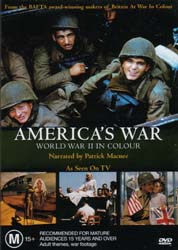America's War: World War II in Colour (2002) |
|
America's War: World War II in Colour (2002) |
|


|
| BUY IT |
| General | Extras | ||
| Category | Documentary |
Main Menu Audio & Animation Featurette-Extra Footage (6) Gallery-Photo Notes-Key Facts |
|
| Rating |

|
||
| Year Of Production | 2002 | ||
| Running Time | 194:51 (Case: 221) | ||
| RSDL / Flipper | RSDL | Cast & Crew | |
| Start Up | Menu | ||
| Region Coding | 2,3,4,5,6 | Directed By | None Given |
|
Studio
Distributor |
 Warner Vision |
Starring | None Given |
| Case | Amaray-Transparent-Secure Clip | ||
| RPI | $39.95 | Music | Chris Elliot |
| Video | Audio | ||
| Pan & Scan/Full Frame | Full Frame | English Dolby Digital 2.0 (192Kb/s) | |
| Widescreen Aspect Ratio | None | ||
| 16x9 Enhancement | No | ||
| Video Format | 576i (PAL) | ||
| Original Aspect Ratio | 1.33:1 | Miscellaneous | |
| Jacket Pictures | No | ||
| Subtitles | English | Smoking | Yes |
| Annoying Product Placement | No | ||
| Action In or After Credits | No | ||
After the success of Britain At War in Colour and The British Empire In Colour, both acclaimed documentary series featuring rare and never-before-seen footage of Britain and her people during World War II, and the spread of the Empire in full living colour, it was only natural that another series would be made. The result of more extensive searching for rare, hidden, and often discarded footage is America's War - World War II in Colour. Playing out over four episodes and more than three hours, this is effectively a history of America's involvement in World War II, albeit told briefly, and only really focusing on those areas where there is colour footage to support it. From the early 1930s and the depression, the outbreak of World War II and America's attempt to remain neutral, the attack on Pearl Harbor and subsequent drawing of America into the war, it is all here in full glorious colour. Some of the colour material was actually shot by Hollywood filmmakers of the time (John Ford filmed the Pearl Harbor aftermath). As a result, the quality is often exceptional, with clear, well lit subjects, and few camera movements. The colour footage itself brings a sense of immediacy and relevancy. It places us right in the footage and makes it appear so much more current, real, and shocking.
Some of the statistics that make up the agony and grim reality of the event that was World War II are just staggering. The more well-known facts are that 55,000,000 people died in the six year conflict, 30,000,000 in Europe alone, with a staggering two-thirds of these being civilians. Some of the facts that I didn't know until watching this series:
In 1937 America's army was smaller than Romania's.
American casualties in the war only numbered 400,000 (I say only with all due respect, but this does equate to less than one per cent of the total deaths - an amazing figure that I thought was much higher).
Before the war America's navy had about 800 ships. At the end they had more than 7,000.
There are four episodes making up this series:
The lead up to World War II. The depression era and America's desire to remain neutral. Best encapsulated by President Franklin D. Roosevelt's stirring speech during the early days of WWII climaxing with the statement that "America Hates War". We see the declaration of war by Britain on Germany and the subsequent request to the US for help, through to the infamous day in December 1941 when the attack on Pearl Harbor dragged America into the conflict.
Three million men are drafted into the US military in 1942 alone. This episode looks at the training undertaken by these men and the effect that the war is having on the general population back in the US. Meanwhile, the battle rages in both Europe and the Pacific.
From the Normandy landings on June 6, 1944 through to the surrender of the German forces in May 1945, this episode contains some of the more disturbing images. With the Allied push through Europe comes the discovery of the concentration camp victims at Buchenwald and Dachau. If you thought the similar camp scenes in Band Of Brothers were disturbing, you will shudder when you see just what some humans were capable of doing to millions of Jews during the war.
The battle in the Pacific. The taking of the island of Guadalcanal as seen in The Thin Red Line, and the battle of Iwo Jima are two of the battles that receive attention in this episode as well as the final blitz on Japan. The dropping of the atomic bomb on Japan and the surrender of the imperial forces round out the episode.
When you are looking at colour footage from World War II, which ended nearly 60 years ago, the quality really doesn't seem to matter too much. I was constantly reminding myself just how remarkable it was to actually see some colour footage of the various moments in history that I have only ever known previously in black and white. Seeing footage of famous figures such as Winston Churchill, Franklin D. Roosevelt, Stalin, Hitler, or a young John F. Kennedy and events such as the Berlin Olympics, the aftermath of Pearl Harbor, and Iwo Jima in full colour is really quite amazing. If ever there were problems with source material not being as pristine as you would like, well this is it. With colour film dating from 1931 onwards it is likely to have all manner of imperfections, holes, scratches, and worse. But make no mistake, a significant amount of work went into restoring the film and some of the results are stunning. Some footage looks like it was shot yesterday, it is that clean and sharp. Some is quite grubby and is filled with artefacts of all manner and size, but it really doesn't matter, it is all equally as fascinating.
Presented in an aspect ratio of 1.33:1, this transfer is not 16x9 enhanced.
Remember that with the age of the material on offer here, factors such as the sharpness of the transfer and the amount of shadow detail is likely to differ greatly. Some of the material is excellent, with good sharp images and no shadow detail problems. Other examples are very ordinary with fuzzy images or lost clarity throughout. Grain is pretty much evident throughout, but it is inherent in the source and cannot be complained about. There is no low level noise.
Colours are what this series is all about, and this transfer does not disappoint. There are no problems other than those inherent in the source (such as fading or cross colouration and oversaturation).
There are no MPEG artefacts in the transfer. Film artefacts as mentioned above are obviously everywhere, though many have been cleaned away. It really wasn't expected to see them all removed.
There is only one set of subtitles present. These are in English and are mostly accurate.
While this is a dual layered disc, I failed to notice any layer changes. I think it is safe to assume that the four episodes are split over the layers.
| Sharpness | |
| Shadow Detail | |
| Colour | |
| Grain/Pixelization | |
| Film-To-Video Artefacts | |
| Film Artefacts | |
| Overall |
Ignore the packaging which states this disc contains a Dolby Digital 5.1 soundtrack. It doesn't, though it isn't missed as this is a soundtrack dominated by narration. Narrated by English actor Patrick MacNee, the dialogue is excellent, with clear and consistent levels. Audio sync is not really an issue as most of the vision doesn't come with the original sound and there are no interviews or talking heads present.
The score is quite haunting. Composed by Chris Elliot, it was designed to capture the sad and dire realities of war. Quite moving at times when accompanied by the stunning visuals.
There is no surround channel nor subwoofer usage.
| Dialogue | |
| Audio Sync | |
| Clicks/Pops/Dropouts | |
| Surround Channel Use | |
| Subwoofer | |
| Overall |
Six snippets of extra footage, running for around three to six minutes each. Topics covered include the Pearl Harbor aftermath and Battle of Midway footage shot by director John Ford and a training film made by movie star Clark Gable.
Automatically running for 3:10 minutes, this gallery has 19 full size colour photos presented in an aspect ratio of 1.33:1. There is a little aliasing on a couple of them and there is no soundtrack accompaniment. Some music would have been a nice inclusion.
You are able to select each year from 1933 to 1945 and view selected important facts from the war and other non-war issues. If the fact has a piece of key footage attached you are able to click on an icon and move straight to that part of the documentary. Quite comprehensive, although it lists Mount Rushmore as being in Vermont - I thought it was in South Dakota.
NOTE: To view non-R4 releases, your equipment needs to be multi-zone compatible and usually also NTSC compatible.
I can't find any reference to this exact documentary being available as yet in Region 1. There are a couple of other World War II colour film documentaries available, but they were made a couple of years earlier. I cannot say if they contain the same set of source footage, though I would imagine there is only a finite amount of it in existence.
The Region 2 disc is identical to the Region 4 version in every respect.
The quality of this video is remarkable given the age of the source material. The transfer has seen a significant amount of time and effort put into restoration of the film and it really shines at times. This is film footage that any World War II buff should own.
The audio is as good as it needs to be. The packaging lists a Dolby Digital 5.1 soundtrack. It isn't. We get a Dolby Digital 2.0 effort and it performs the task required of it effortlessly.
The extras are fairly brief but worthy.
Recommended, especially if you already own Britain At War In Colour or The British Empire in Colour.
| Video | |
| Audio | |
| Extras | |
| Plot | |
| Overall |
| Review Equipment | |
| DVD | Loewe Xemix 5106DO, using RGB output |
| Display | Loewe Calida (84cm). Calibrated with Video Essentials. This display device is 16x9 capable. |
| Audio Decoder | Built in to amplifier/receiver. Calibrated with Video Essentials. |
| Amplification | Harmon/Kardon AVR7000. |
| Speakers | Front - B&W 602S2, Centre - B&W CC6S2, Rear - B&W 601S2, Sub - Energy E:xl S10 |